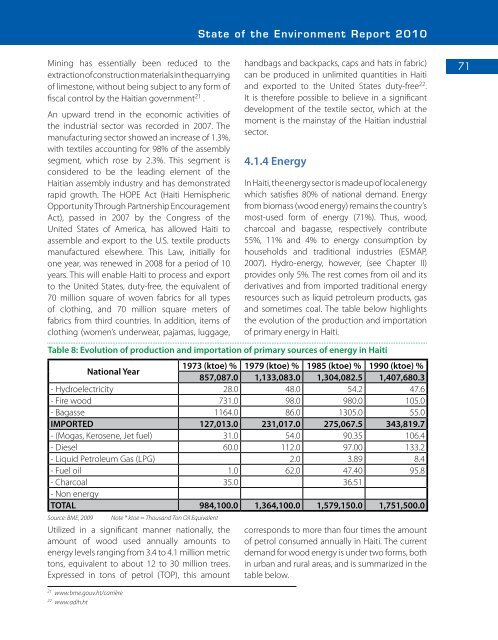GEO Haiti 2010
GEO Haiti 2010
GEO Haiti 2010
You also want an ePaper? Increase the reach of your titles
YUMPU automatically turns print PDFs into web optimized ePapers that Google loves.
State of the Environment Report <strong>2010</strong><br />
Mining has essentially been reduced to the<br />
extraction of construction materials in the quarrying<br />
of limestone, without being subject to any form of<br />
fiscal control by the <strong>Haiti</strong>an government 21 .<br />
An upward trend in the economic activities of<br />
the industrial sector was recorded in 2007. The<br />
manufacturing sector showed an increase of 1.3%,<br />
with textiles accounting for 98% of the assembly<br />
segment, which rose by 2.3%. This segment is<br />
considered to be the leading element of the<br />
<strong>Haiti</strong>an assembly industry and has demonstrated<br />
rapid growth. The HOPE Act (<strong>Haiti</strong> Hemispheric<br />
Opportunity Through Partnership Encouragement<br />
Act), passed in 2007 by the Congress of the<br />
United States of America, has allowed <strong>Haiti</strong> to<br />
assemble and export to the U.S. textile products<br />
manufactured elsewhere. This Law, initially for<br />
one year, was renewed in 2008 for a period of 10<br />
years. This will enable <strong>Haiti</strong> to process and export<br />
to the United States, duty-free, the equivalent of<br />
70 million square of woven fabrics for all types<br />
of clothing, and 70 million square meters of<br />
fabrics from third countries. In addition, items of<br />
clothing (women’s underwear, pajamas, luggage,<br />
handbags and backpacks, caps and hats in fabric)<br />
can be produced in unlimited quantities in <strong>Haiti</strong><br />
and exported to the United States duty-free 22 .<br />
It is therefore possible to believe in a significant<br />
development of the textile sector, which at the<br />
moment is the mainstay of the <strong>Haiti</strong>an industrial<br />
sector.<br />
4.1.4 Energy<br />
In <strong>Haiti</strong>, the energy sector is made up of local energy<br />
which satisfies 80% of national demand. Energy<br />
from biomass (wood energy) remains the country’s<br />
most-used form of energy (71%). Thus, wood,<br />
charcoal and bagasse, respectively contribute<br />
55%, 11% and 4% to energy consumption by<br />
households and traditional industries (ESMAP,<br />
2007). Hydro-energy, however, (see Chapter II)<br />
provides only 5%. The rest comes from oil and its<br />
derivatives and from imported traditional energy<br />
resources such as liquid petroleum products, gas<br />
and sometimes coal. The table below highlights<br />
the evolution of the production and importation<br />
of primary energy in <strong>Haiti</strong>.<br />
71<br />
Table 8: Evolution of production and importation of primary sources of energy in <strong>Haiti</strong><br />
National Year<br />
1973 (ktoe) % 1979 (ktoe) % 1985 (ktoe) % 1990 (ktoe) %<br />
857,087.0 1,133,083.0 1,304,082.5 1,407,680.3<br />
- Hydroelectricity 28.0 48.0 54.2 47.6<br />
- Fire wood 731.0 98.0 980.0 105.0<br />
- Bagasse 1164.0 86.0 1305.0 55.0<br />
IMPORTED 127,013.0 231,017.0 275,067.5 343,819.7<br />
- (Mogas, Kerosene, Jet fuel) 31.0 54.0 90.35 106.4<br />
- Diesel 60.0 112.0 97.00 133.2<br />
- Liquid Petroleum Gas (LPG) 2.0 3.89 8.4<br />
- Fuel oil 1.0 62.0 47.40 95.8<br />
- Charcoal 35.0 36.51<br />
- Non energy<br />
TOTAL 984,100.0 1,364,100.0 1,579,150.0 1,751,500.0<br />
Source: BME, 2009<br />
21<br />
www.bme.gouv.ht/carrière<br />
22<br />
www.adih.ht<br />
Note * ktoe = Thousand Ton Oil Equivalent<br />
Utilized in a significant manner nationally, the<br />
amount of wood used annually amounts to<br />
energy levels ranging from 3.4 to 4.1 million metric<br />
tons, equivalent to about 12 to 30 million trees.<br />
Expressed in tons of petrol (TOP), this amount<br />
corresponds to more than four times the amount<br />
of petrol consumed annually in <strong>Haiti</strong>. The current<br />
demand for wood energy is under two forms, both<br />
in urban and rural areas, and is summarized in the<br />
table below.

















